Observe — photos, traces, way geometry editing and more!
Posted by geohacker on 13 July 2020 in English.A little over a year ago, I wrote about Observe — a new field mapping tool for OpenStreetMap that works offline. There was a lot of interest from the community to use Observe and we got a lot of great feedback. Ever since, we have slowly been working on adding new features and improving the overall performance.
Few weeks ago, we released a new version of Observe. I’m excited to invite you all to test this version and give us feedback. I’ll highlight some of the changes in this release.
You can download the development version of Observe for Android and iOS from here. Note that this uses the OSM Dev API. If you don’t have an account, you can create one. You can read about all Observe features and how to use them in the user manual.
Taking photos and recording traces
Two important features that we wanted to add to improve the field mapping experience of Observe is being able to capture photos and record traces. Photos are critical when it comes to mapping outdoors, as we tend to take pictures of features so we can refer to them later on to create additional tags. For example, I take pictures of the sign boards of businesses so I can enter address and opening hours when I’m back at my computer.
 1. Taking geotagged photos. 2. Taking photos associated to features
1. Taking geotagged photos. 2. Taking photos associated to features
Observe allows users to take photos that are geotagged, but more importantly, photos can be associated with existing OpenStreetMap features or a feature that you just created.

Recording the path a field mapper took during the mapping exercise can be really useful to compare routes from different mappers, use it for accountability, or turning those into roads or sidewalk geometries later on. While mapping, users can turn on recording and Observe will prepare a GeoJSON line string of the entire path followed.
Photos and traces captured through Observe Mobile will be available offline and uploaded to the Observe Dashboard when the user comes online.
Observe Dashboard
To manage photos and traces generated from Observe Mobile and to allow for further integrations of these auxiliary data, we built Observe Dashboard.

Photos can be downloaded and traces can be opened directly in JOSM using the remote control. We hope this integration will make it easier for mappers to introduce additional tags to features they added during the field exercise.

At the moment, any user can login to Observe Dashboard with their OSM dev account to see all photos and traces uploaded to the API. Since this is the development version, data that you send to the dashboard could be deleted anytime.
Editing and creating way geometries
When we released Observe last year, users could only add and edit point geometries. A lot of people expressed interest to have basic geometry editing functionality. We know way geometry editing can be problematic especially when modifying shared nodes or editing features that are members of relations.
Our approach has drawn inspiration from tools like GoMap!! and Vespucci, and rely on using map styles and offering the user several decision points before changes are made to feature geometries. Users can draw lines and polygons, modify existing lines and polygons, add and delete nodes, snap to existing nodes, and merge nodes.


We don’t allow users to delete nodes and ways that are part of relations, or change the preset / feature type of such features. When editing features that are members of relations, there’s a warning that communicates to the user the impact of what they are about to do.
These steps safeguards against accidental edits, but is definitely not a comprehensive approach. We look forward to hearing more ideas and feedback from you.
Future
There has been a lot of interest in using Observe outside of adding geometries to the map. One of the strong ideas we’ve been working on is adding capabilities to design surveys and campaigns. We might also consider integrating with existing tools like Tasking Manager.
Observe is still in a development mode and there are no production builds for OpenStreetMap. If your project could use this tool and are interested in collaborating, please reach out to us (sajjad@developmentseed.org). Figuring out a roadmap to get Observe on the app stores is something that we are working on right now, though, there’s no timeline for this.



 Map of recently reverted changesets
Map of recently reverted changesets